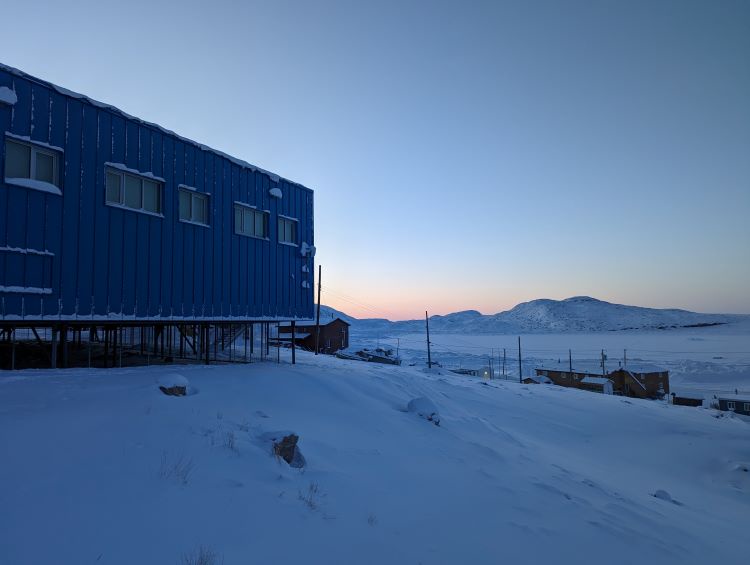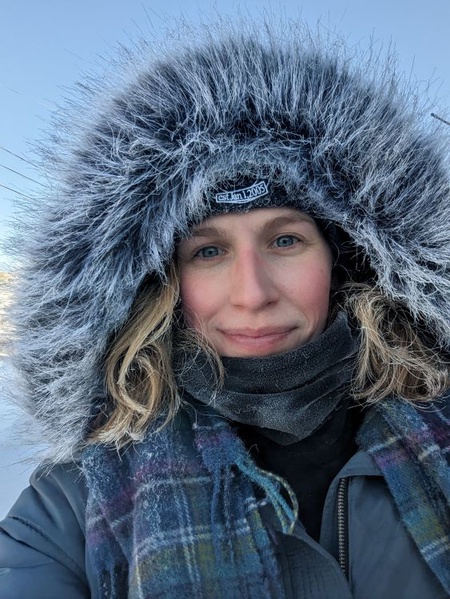Isabelle Gapp, Interdisciplinary Research Fellow in Art History, has received British Academy funding for her collaborative project on coastal sea ice, working with Sarah Cooley (University of Oregon) and the West Baffin Co-operative in Kinngait, Nunavut.
The Universities of Aberdeen and Oregon have partnered with Canada's oldest Indigenous owned and Inuit led arts organisation, the West Baffin Cooperative, to study the loss of sea ice surrounding its art studio in Kinngait, located on Baffin Island in Canada's far north.
Using printmaking and drawing, alongside satellite imagery, From the Floe Edge examines the stories, science, and visual histories of coastal sea ice which forms along the remote community’s coastline during winter and spring.
While research has been carried out into sea ice around Kinngait before, it has largely focused on monitoring sea ice conditions for shipping and transportation. In collaboration with local Inuit artists, hunters and residents, which rely on sea ice, researchers from both universities intend to use an interdisciplinary, visual approach to understanding evolving local sea ice conditions. They are specifically interested in understanding the important local indicators of sea ice change, and how these indicators have changed over the past three decades.

(Above) Kenojuak Cultural Centre and Print Shop, Kinngait
Around the Circumpolar North, sea ice has been and remains a recurring motif in art history and contemporary visual culture. As opposed to a sublime aesthetic of ice, which remains central and problematic in art history, for Inuit artists in Kinngait, sea ice is closely interconnected with their social and cultural identity. Not only is the frozen shore visible from the windows of the Kinngait Studios, but the artist's own experiences of the sea ice, many as hunters, extends into the picture plane. This project will consider drawings and printmaking of the sea ice and floe edge - what is on, within, and under the ice - by Inuit artists, including Padloo Samayualie, Qavavau Manumie, and Ooloosie Saila, in conversation with glaciology and sea ice studies.

(Above) Padloo Samayualie, Spring, 2018, coloured pencil and ink on paper. Image: Dorset Fine Arts
It also aims to offer a local perspective on sea ice change, deepening our understanding about Inuit people and their culture. The experience of coastal sea ice, siku, and the floe edge, or sinaaq, varies across Arctic communities. By analysing and understanding the ice edge position, ice thickness, ice quality and length of ice season, researchers hope to address questions about local sea ice change and its climatological divers.
The project was made possible thanks to a £259,000 ($447,000 CAD) grant from the British Academy Knowledge Frontiers International Interdisciplinary Research programme.
Dr Isabelle Gapp, Interdisciplinary Research Fellow in the Department of Art History, said: “We're really excited to work alongside the artists at the Kinngait Studios to explore how Arctic visual culture and glaciology might understand historic and future sea ice changes.”
Dr Joanne Anderson, Head of Art History, added: “I am absolutely delighted for Issy and her international collaborators who are now able to embark on this exciting interdisciplinary project on coastal sea ice, past, present and future.”
West Baffin Cooperative President, Pauloosie Kowmageak, said: “We are very excited to participate in this groundbreaking and multinational initiative that bridges environmental science and the visual arts. This project will certainly highlight the unique observational skills of Kinngait artists, who have carefully documented their surroundings through drawing, print and sculpture since the very beginnings of Inuit creative expression.”


